
102
Latin Name
Leiopython albertisii
Common Name
(Northern) White Lipped Python.
Adult Size
150cm - 210cm.
Distribution
The Northern white lipped python (Leiopython albertisii) is found on the island of New Guinea and is distributed to the north of the central dividing mountain range that runs the length of the island. Populations are found from Sorong on the Birds head (Vogelkop) peninsular and a few large islands in the west of Irian jaya, to Madang in the east of Papua.
There are reported populations on the St Matthias islands to the north of the Bismarck archipelago. (O'shea 2011)
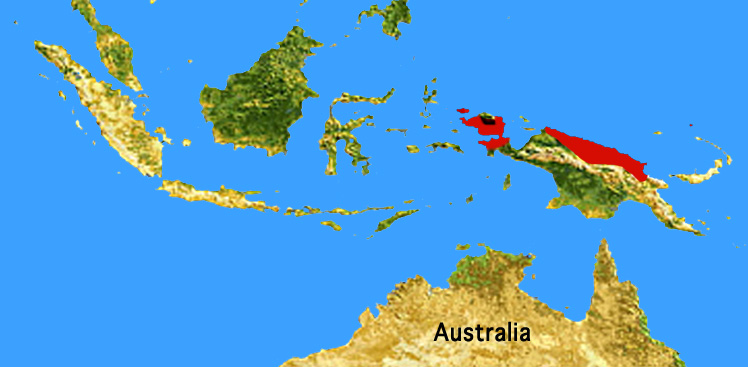
Habitat
Lowland forests and rainforest often found near river systems, streams or other water sources.
General Description
The genus Leiopython comprises of two species Leiopython albertisii (Northern or Gold phase) and Leiopython fredparkeri (meridionalis) (Southern or Black phase). (Natusch et al 2020)
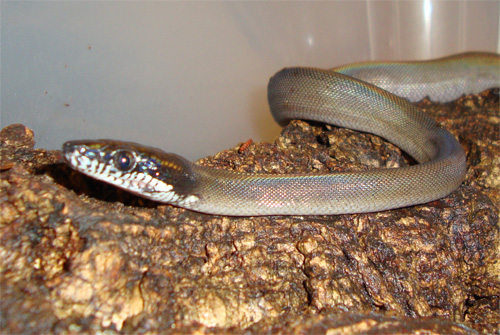
A very young White lipped python showing olive gray body and characteristic head colouration.
Hatchlings emerge from the egg around 50cm long.
At first glance Leiopython albertisii is a rather uninteresting brown snake with a black head, although upon closer inspection the beauty of these snakes really shows through.
Undergoing an ontogenetic colour change as they mature, young albertisii have a base body colour of dark olive gray with small darker markings scattered along the lateral surface and have a black head with the characteristic white lips. The ventral surface is a greyish brown and can have darker speckling although the underside of the head is white.
It is as they mature that the skin takes on the most beautiful iridescence and when captured in the right light looks as though the entire snake has a covering of oil on it's scales. As they grow the body colour changes to a dark brown along the dorsal surface, fading through a rich golden brown, yellow to a cream along the lateral into a rich cream white on the lower lateral surface. The scales develop a dark edge giving the snake a fishnet appearance along it's sides as can be seen in the image below.
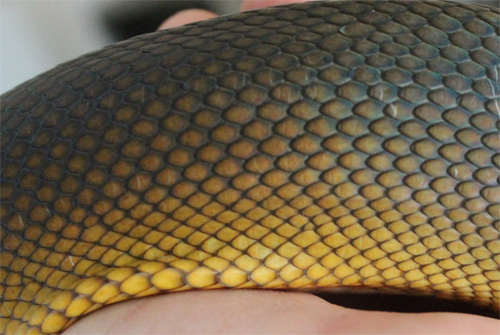
The head is distinct from the neck and is elongated. The body is reasonably slender for the size of the snake compared to many other terrestrial python species. Even so they are extremely powerfully constrictors. The eyes are gray in colour and during the day have a very narrow vertical pupil indicating their nocturnal nature.
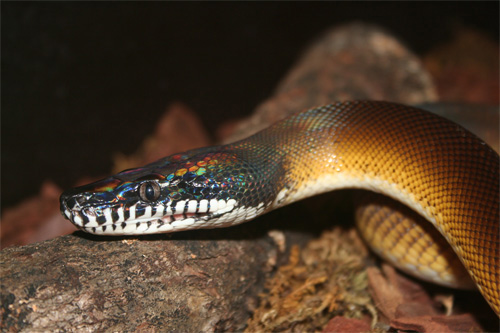
Close up view of the upper labials showing the
black anterior and white posterior colouration
of this species,
There are heat sensitive pits in the upper and lower jaws, with two pits on each side of the upper jaw and five on each side of the lower jaw. These pits are used in the location of prey by these nocturnal hunters.
Leiopython albertisii will spend the daylight hours resting in the leaf litter and under debris on the forest floor and have also been found in caves. At dusk they become active and start foraging for prey rather than waiting in ambush like many other python species.
Young albertisii are known to feed on small lizards, whilst larger more mature animals have a diet that consists mainly of mammals, with remains of bandicoots and small rodents being found in the stomachs and faeces of specimens. (Natusch, Lyons 2012)
Although mostly terrestrial in nature white lipped pythons can and do climb. Unlike the more arboreal pythons found in the same geographic region, white lipped pythons do not have prehensile tails.
When young however they do have what I would describe as semi-prehensile tails and will often hang from branches in a terrarium by their tails to consume prey.
Compared to many other python species, white lipped pythons have fairly small teeth.
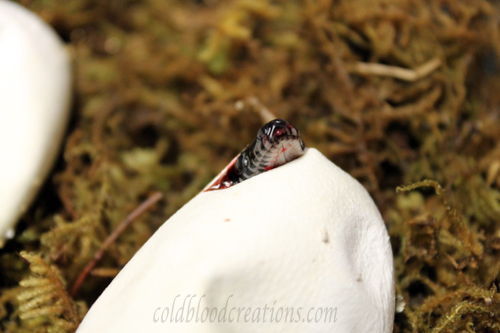
First look at
the world for
this white
lipped python sixty days
after the egg
was laid.
Captive Care
Housing. Although highly nocturnal and very secretive during the daylight hours, Leiopython albertisii are extremely active at night and require a reasonable amount of space in captivity.
There are various options as to how you can house your white lip python, including, all glass terrariums, plastic boxes, home built wooden terrariums and commercially made acrylic or plastic terrariums. All these examples have advantages and disadvantages compared with each other such as cost, how well they hold heat / humidity and how easy they are to keep clean.
Young animals tend to do very well in small plastic tubs in a rack style set up for the first six months to a year. The humidity can be easily maintained and this will help keep the young delicate snakes hydrated and help them shed well. The substrate can be paper towels as they are easily changed to clean the enclosure and will help keep the humidity up if kept slightly damp. Plastic netting can be used to provide a climbing structure and young white lips will often emerge around the time the lights go out to climb and rest on top of any perches provided.
When very young I keep babies in a rack set up in fairly small tubs measuring 40cm(l) x 30(w)cm x 18(h)cm and will use damp moss as a substrate or paper towels with damp moss hide boxes. I find this size container works well for younger animals up to and around six months to a year of age.
I used to change from a paper substrate to bark chip once the snakes were around six months of age although more recently I have been using Coconut Fiber as a substrate for young white lips. I decided to change to the Coconut Fiber substrate after trying it with young ringed pythons. The ringed pythons would bury themselves in the substrate and form tunnels within it. Although the white lips do not seem as fossorial in nature as the ringed pythons they will still burrow into the substrate.
Once in adult size terrariums I keep the snakes on a soil substrate that lets me control the humidity in my enclosures at consistent, relatively high levels. There is more information about the soil substrate I use in the terrarium section of this web site.
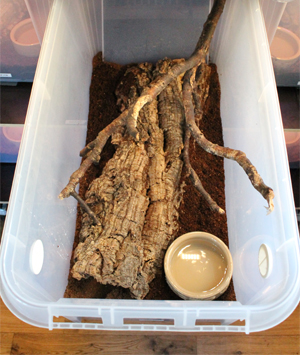
Grow out tub for juvenile white lipped python measuring (70cm x 40cm x 40cm) showing coconut fiber bedding and large cork bark hide.
During the day white lips are very secretive and need secure hiding places in order to avoid stress. For larger adult animals large pieces of cork bark can be used and several should be provided per animal at different locations in the terrarium. This will allow the python to choose a hiding place in the terrarium that best suites its needs at any given time with regards to temperature and humidity.
Damp moss can also be placed in piles in the terrarium and will often be used by the snakes as hiding places and somewhere to burrow beneath. Another option that I have found works very well is placing damp sphagnum moss in plastic hide boxes, especially in winter when the humidity in my house is very low.
Younger animals can be provided with cardboard boxes, tubes or small plastic tubs as hiding places.
Humidity.White lipped pythons require fairly high humidity. This should be provided although care must also be taken not to allow the terrarium to become and remain too wet as this can cause mould growth in the terrarium and health problems such as scale rot in this terrestrial species. Spraying water over the substrate on a daily basis can help keep humidity levels up. The surface of the substrate should be allowed to dry out over the following 24 hrs after spraying.
Leiopython species have very thin delicate skin and can dehydrate very quickly if humidity drops too low and fresh water is not provided at all times. The thin skin can also cause problems when shedding if humidity is not kept high.
If maintaining high humidity is an issue then damp moss can be placed inside hide boxes to help meet the needs of the snake although care must be taken to ensure that the moss does not become moldy.
Temperature. White lip pythons do well when given a temperature gradient within the enclosure. This allows the snake to choose the temperature that it needs at various times. In general the enclosure should have a warm side and a cooler side. Heat can be provided by heat mats, heat panels, heat cable or ceramic heaters. Again there are advantages and disadvantages to each but whichever heating method you choose, it should be controlled by a reliable thermostat.
I provide my adult animals with a daytime air temperature of 28 deg C to 24 deg C using heat panels fixed to the terrarium ceiling and controlled by pulse proportional thermostats. This offers a basking spot temperature of 30 deg C directly under the heaters. The terrariums my white lips are housed in are stacked and so also receive some heat from the terrariums below them and this warms the substrate to a temperature of 30 deg on the warm side of the enclosure. At night the air temp drops to a high of 25-26 deg.
I provide young albertisii with a constant temp gradient of 30 deg at the warm side of their tubs to around 26 deg on the cool side with no night time drop. These temperatures are provided using heat mats placed on the back wall of the rack and controlled by a thermostat.
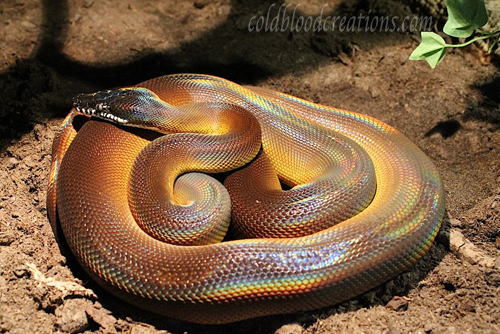
Lighting. White lipped pythons are highly nocturnal but will benefit from some form of light reaching their enclosure as this will provide a natural light cycle. It can be as simple as making sure the area in the house where they are kept receives some natural light from a window each day, although this gives no possibility of manipulation of daylight cycles, or by using artificial lights inside the enclosure. Over the years I have tried various different lighting options from full spectrum fluorescent lights, halogens to cheap led lights, all with reasonable success.
I now light my white lip enclosures with full spectrum arcadia jungle dawn LED lights. I provide a 12 hour daylight cycle as this replicates their natural environment.
By keeping a regular daylight cycle, I have found white lips quickly sync to the daylight schedule and will often emerge from their hiding places around 30 minutes before the daylights go out. Because of this I have also added low output red LED night lighting. After the daylights go out the snakes can be viewed without too much disturbance using the low output red LED lights. I usually feed all my snakes including my white lips at night after the daylights switch off and the red LED's help with this, negating the need for torches or any other sort of lighting. When not observing them or feeding them the low output red LED's are switched off.
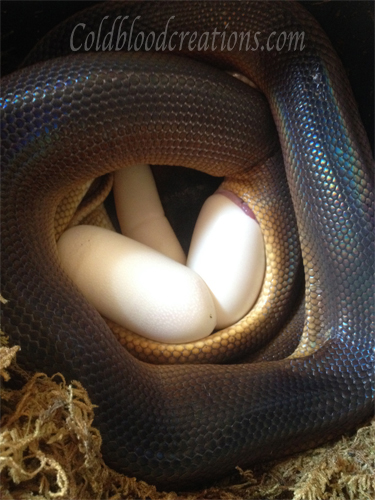
White lip python in the early stages of laying her clutch.
Food.Young white lip pythons will eat small defrosted fuzzy mice. These pythons have a fast metabolism and so can be fed quite frequently. I will feed very young animals around every seven to ten days for the first few months of age and then reduce the frequency to every ten to fourteen days.
I have found that younger animals that are able to take adult mice may sometimes take a little provocation to strike at the prey but often much more readily take rat pups.
Adults and animals over two years of age can be fed one or more appropriate sized defrosted rats around every fourteen days although I generally feed around every three weeks or so. Once feeding well, they are veracious feeders and will eat almost as much as you offer them. Care must be taken to keep an eye on their weight and body condition, as although they have a high metabolism and are extremely active, they can quickly become obese. Keeping an eye on the snakes scales can help reduce obesity. Scales along the body of the python should sit flush to each other and show no skin between them. If you start to see skin between the scales when the snake is not digesting a meal, the snake is possibly getting fat and feeding frequency and/or prey size should probably be reduced.
In the wild snakes are opportunistic feeders and food does not come along on a regular schedule. With all my snakes I follow feeding schedules loosely and prefer to watch what the snakes are doing. When they become more active after digesting a previous meal and seem to be looking for food I will wait a day or two before feeding them again. However with white lips it is wise to wait several days after they start to forage before feeding again as these snakes are naturally very active.
As a rough guide to how big a meal your white lip python will eat, I offer young animals up to two years of age rodents that are around 15% of their body weight and animals over two years meals between 5% and 15% of their body weight depending on the time of year and the individuals general body condition.
This leads onto record keeping. I believe it is a good idea to keep records of dates when your snake is fed, when it sheds and to keep track of it's weight. Not only will this go some way towards avoiding the overfeeding of your snake, it can also help show any health issue that might arise before they become problematic.
Water.Water should be provided at all times and especially important for white lips should be kept fresh. Plastic, glass or metal containers can be used and the water should be replaced a couple of times a week or whenever soiled. Bowls should be thoroughly cleaned and disinfected every couple of weeks or again when the water has been soiled.
Although white lips reportedly like to soak if provided with large water bowls, I have not found this to be the case. I generally only provide my animals with bowls large enough for drinking rather than soaking in. Whenever large bowls have been provided they have never been used for soaking. Provided care is taken with humidity either by choosing a good substrate or providing moss hides I have not found the lack of soaking to be detrimental to sloughing.
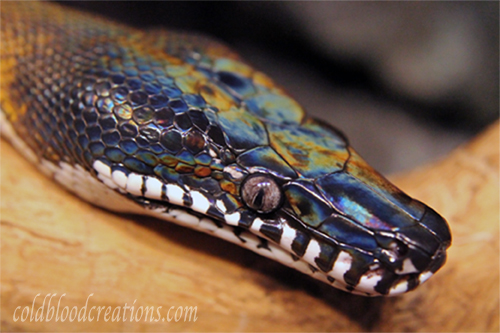
White Lip Breeding.
Here is a link to another page with a lot of information collected over the space of five years or so. It contains data and my own personal thoughts following two successful breedings of Leiopython albertisii 2019 and 2021 as well as information and data from unsuccessful attempts.
Points of interest.
With larger white lipped pythons that have attained their adult white ventral colouration, often the first sign that they are going into a slough cycle is the change in colour of the belly scales. Before the snake takes on the familiar opaque look common to many snakes in slough, white lips belly scales will often turn a flushed pink colour. Often the pink colouration will extend along the whole ventral surface replacing the white but occasionally the pink colouration will appear as blotches on the snakes belly. When first seen it can look like the snake has some sort of skin infection but the pink flush will disappear as the snake turns opaque and the snakes belly will be brilliant white again as soon as it sheds it's skin.
I kept a 2.2 group of white lips in England in the 1990's and tried a few substrates including bark chip, newspaper and wood chip. During this time they constantly suffered with bad sheds and I had to assist shedding often, rarely having any of the group give a complete shed. My adult white lips in Sweden are housed on a soil substrate. It is unusual to have anything other than complete sheds nowadays with my white lips. The soil if kept damp from the bottom up retains high humidity in the terrarium without the surface of the soil remaining wet. This provides the conditions needed to maintain this species whilst avoiding any possible skin infections that could be caused from the snakes laying on a constantly damp surface.
Fresh water should be provided at all times. Leiopython albertisii will quickly dehydrate without fresh water. This is something that I learned the hard way in 1997 whilst maintaining the 2.2 group. I had to take a trip away for a little over a week and before leaving I gave all my animals fresh water and checked that cages were clean. When I returned I found that the larger adult pair of white lips had moved their water bowl towards the warm end of the terrarium. It was sitting over the heated area of terrarium floor and the bowl was completely dry. The terrarium also had very low humidity from a week of no spraying. Both snakes were severely dehydrated and despite soaking both animals, the female died the following day. The male seemed to be ok for a while but he also died soon after the above incident.
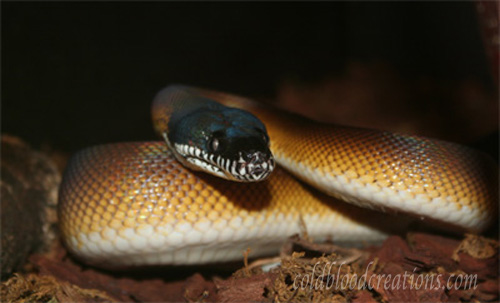
Defensive posture of a white lip python.
White lips are often referred to as aggressive snakes. This is in my opinion generally not the case, and a better way to describe a typical white lip temperament would be defensive. The snakes first line of defence is often to escape. However within the confines of the terrarium this is not possible and so the python becomes defensive, often striking at the threat.
Once removed from the terrarium white lips, especially younger animals are very fast moving. Many will try to escape and in doing so the keeper may restrain the animal a little to firmly causing the snake to bite.
The group of white lips I kept in England in the 1990's were of wild origin, and although once removed from their terrariums would tolerate handling, they were never completely calm and retained a certain amount of defensive behaviour throughout their lives.
I have found with individuals that have been born in captivity, handling on a regular basis when young often results in a white lip with a fairly mild temperament. The simple act of removing a young animal from it's tub to another tub once every few days in order to clean, if done with care, I find leads in general to animals that are much more reluctant to bite. In my experience sub-adult and adult animals (if raised from young) tend to naturally become calmer and more workable as they age although there will always be exceptions.
My largest female white lip has never bitten after an initial few bites when very young and allows me to freely remove her from her terrarium without the use of a hook. Once out she remains calm and is extremely easy to handle.
If your main goal is to keep a white lip python that is easy to work with and a joy to handle then I would strongly recommend trying to source a young captive bred animal.
I should also mention that I feed all my animals after lights out and never attempt to handle them after lights out unless absolutely necessary. I believe that this goes some way toward "training" the animal that any movement within the terrarium during daylight hours is not food and so avoids any possibility of a feeding response bite.
White lips are fairly vocal snakes and will often make short hissing noises when first picked up or disturbed. These do not seem to be aggressive in nature but more a form of communication. Whilst handling, my largest female often emits short hisses but shows no sign of distress or aggression when doing so. She will always give a few short hisses when first picked up.
I have also found that the hissing only seems to happen once the snakes have grown to over a year or two of age. Before this, young white lips will often flick their tails in a similar fashion to how a rattle snake rattles it's tail. This seems to be a warning to not touch and can often induce a bite or the snake musking or defecating on you if the warning is not heeded. Once the young white lips begin to tame down and stop biting so much they will still often rattle their tails when disturbed.
Another very interesting behaviour in these pythons is the regurgitation of (for want of a better description) furr balls. Every so often white lips will cough up what looks like a long furry wet pellet. This happens at night and I have found it to happen four to five days after the snake eats.
Although I have kept white lipped pythons on and off for over twenty years since the early 90's I had never witnessed this behaviour until March 2015. The particular snake that I saw regurgitate was a four year old female. She was sat out in the open in her enclosure around two hours before the lights went out in the evening. This was very unusual behaviour for her as she would normally only show herself around 30 minutes before the lights went out. She seemed unaware of me looking at her which was also unusual behaviour for her and when I open her terrarium she showed no alertness. I reached into the terrarium to move a piece of cork bark that she was resting on to see her reaction. She still seemed vacant not moving much as if in a trance. A moment later she began to move slowly around the terrarium. She then stopped and laid still for around 15 seconds before arching her back. What I would describe as a wave then rippled up her body from near her tail towards her head. Her muscles were contracting along with the wave moving up her body until it was approx 1/3 of her body length from the head and at this point she opened her mouth and started making rasping, gurgling, vomiting noises which ended around two seconds later with a sort of hissing cough and a shake of her head. She then lay perfectly still for another few seconds before moving off and hiding under a large piece of cork bark.
Although the movement was too quick to actually see the furr being cast she left behind a large furr cast where her head had been. The whole process from her convulsing to casting took between five and ten seconds.
What's in a name?
Anyone that has had an interest in white lipped pythons for any length of time will most likely be aware of the seemingly continuous scientific name changes for this python complex. From Liasis to Leiopython to Bothrochilus etc numerous times.
When I first kept white lips in England they were Liasis. When I began keeping them again in Sweden several years later they were Leiopython and whilst writing this page they have been Leiopython and Bothrochilus several times depending on which publication or paper you read.
Whatever scientific genus the white lips are placed in doesn't change the fact that they are one of the most interesting and rewarding python species to work with.
The above information is collected from various sources (click here for references) and from personal observations.
The captive care section is based on how I personally maintain this species. This is not the only way to successfully maintain this species and other keepers use different methods.
This is what works for me, with my animals and the size of collection that I work with.
